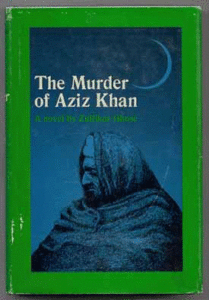Book Review: The Murder of Aziz Khan
By Nusrat Khawaja | Bookmark | Published 7 years ago

Zulfikar Ghose has lived most of his life outside Pakistan but is a well-regarded figure in the canon of Pakistani writers in the English language. Born in Sialkot in 1935, his family emigrated to England shortly after Partition. The land of Ghose’s birth along with all the places he subsequently lived in, became frames of reference to explore human behaviour in his writing. His first novel, The Contradictions (1966), looked at the British elite in India. It was in his second and tragic novel, The Murder of Aziz Khan (1967), that he framed the narrative in the land of his birth.
The paramount arena of action in The Murder of Aziz Khan is a fictional town in Punjab called Kalapur. This small but flourishing town is set in cotton-growing land. A cultivator, Aziz Khan owns 70 acres of land and he personally supervises the 46 peasants who work on it. Within the framework of the novel, Ghose depicts Aziz Khan as the elemental man, who lives close to nature.
Aziz Khan’s wife, Zakia, and his two sons, Rafiq and Javed, are significant figures in the story. They sculpt the contours of Aziz Khan’s character and contextualise him within his traditional rural world towards which urbanity edges inexorably.
The three Shah brothers, in counterpoint to Aziz Khan, are the face of early capitalist enterprise in Pakistan. They have textile mills, wealth and a hunger to expand their assets and influence. The Shahs’ ability to influence by bribery helps them acquire a legitimacy that is utterly self-serving. Kalapur’s proximity to cotton-growing land makes it an advantageous hub for them to settle in when they emigrate to Pakistan from Bombay (Mumbai).
They proceed to buy out local farmers with alarming speed. Many farmers relinquish their ties to the land with relief and look forward to reinventing a less toilsome life in the city. Not so Aziz Khan. The thought of giving up his land is anathema to him. His land becomes an island encircled within the newly acquired estates of the Shah brothers. This uneasy proximity of two diametrically opposite forces generates the tragic impulses that will determine the gains and losses that play out in the novel.
There is heavy play between the dualities of aggression and passivity, guile and naivety, feral passion and servility, justice and wrongdoing in the novel. The authorial voice interjects from time to time, with great cynicism, to describe the sea-change that is overcoming time-tested modes of existence: “Any society with pretensions to the complexities of civilisation swarms with middlemen…who produce nothing and achieve nothing and yet acquire a fortune for themselves.”
The Murder of Aziz Khan is a story that sharply indicts unbridled capitalist greed. In the wider context of postcolonial literature, the clash between farmer and industrialist is depicted from an indigenous viewpoint rather than through the ideological lens of postcolonial or Marxist theory. The novel examines how brash materialism creeps into society and disturbs the rural order. The success with which the moneyed settlers elbow their place in the social order casts light on the complex issue of identity formation in post-partition Pakistan. Financial corruption seeps into the many layers of this small town community.
Zulfikar Ghose is known for experimenting with assorted writing styles in his novels and poems. The Murder of Aziz Khan was his experiment with writing a traditional novel in the Realist style, which derived its plot from social reality. It was not intended to be a historical novel but, capturing as sharply as it does the nuances of time and place, and keeping in mind contemporary realities in the ruthless land acquisition game, its authenticity has become more profound over the decades.


